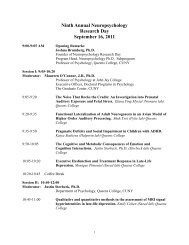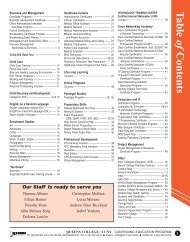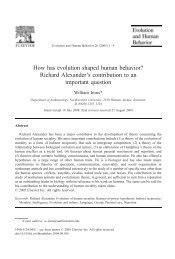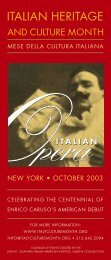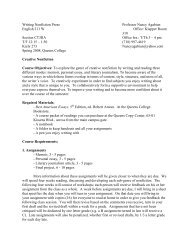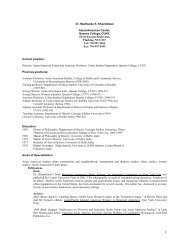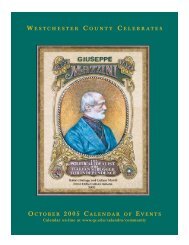paper (pdf) - Queens College - CUNY
paper (pdf) - Queens College - CUNY
paper (pdf) - Queens College - CUNY
Create successful ePaper yourself
Turn your PDF publications into a flip-book with our unique Google optimized e-Paper software.
Researchers: Kenny Cheng-‐Fung <br />
Shirley Arana <br />
LCD 288: Voices of New York [Spring 2011] <br />
Instructors: Michael Newman <br />
Miki Makihara <br />
Thursday, May 26, 2011 <br />
<strong>Queens</strong> <strong>College</strong>, <strong>CUNY</strong> <br />
Tu vs. Usted: <br />
How formal are you <br />
Introduction <br />
In English there are many pronouns but only one that can refer to ‘you’, ‘you’ can be used with <br />
anyone, your mother, a colleague, student, this however is not the case on other languages. While <br />
language may be the most natural thing that comes to humans, how we chose to express ourselves is <br />
strongly influenced by society and social stratification. In French, German, Italian, Spanish and many <br />
other languages there can be two singular pronouns of address. Both forms of singular pronouns <br />
correlate with social standing, formality and power which makes it very important to use in context <br />
when addressing someone. The variation of pronoun use can give insight to the dimensions of social life <br />
and contribute to the analytical aspects behind social standing, being that how we see ourselves often <br />
tends to depend on how others see us first. A person’s constant style of pronoun use, some say, can <br />
even give away his/her own class status, their mood and attitude. Brown and Gilman in “The Pronouns <br />
of Power and Solidarity” state that the “European development of two singular pronouns of address <br />
began with the Latin tu and vos. In Italian they became tu and voi, in French tu and voi” and in Spanish <br />
tu and vos which is now usted.
Literature Review Background <br />
According to the studies done by Brown and Gilman “the use of the plural to the emperor began <br />
in the fourth century. The choice of vos as a form of address may have been in response to this implicit <br />
plurality. An emperor is also plural in another sense; he is the summation of his people and can speak as <br />
their representative. Royal persons sometimes say ‘we’ where an ordinary man would say ‘I’”. Power is <br />
said to be having control over another or several. Power is being able to control ones behavior or output <br />
and is something that is almost never mutual in most dynamics. The difference in uses of ‘you’ has been <br />
used before. However it is important to notice the suttle difference in the uses of pronouns from now <br />
and then, though both do essentially focus on power, especially then, now through our studies it can be <br />
seen more as a formality and reveal ones level of solidarity with others. Pope Gregory used tu to address <br />
his subordinates and addresses in return with vos. Nobility used to (or variation of) to the common folk <br />
and slaves, even Shakespeare (Byrne 1936) made his noble principals say tu and are given vos in return. <br />
It seems as though the use of usted/vos (again or variations of) has always been introduced into society <br />
(our own or foreign) at a high point and regarded to in such a way. Gradually we see from this study, <br />
past studies and our general interaction with others that the use of singular pronoun has shifted to <br />
display intimacy and formality. <br />
Key Concept <br />
For many especially those who reside in New York, even more specifically <strong>Queens</strong>, New York we <br />
see and hear all kinds of cultures and languages. Everyday more and more people come to this country <br />
to take part in the American Dream. This melting pot of people creates changes and introduces us to <br />
many things. One thing we’ve seen growing up bilingual is just how much language can vary even within
our own small community. Spanish is spoken in many countries, but many Spanish speakers, both native <br />
and non-‐native can say that their Spanish is a unique reflection of them and their culture. In this <br />
particular study we chose to focus on regional Spanish and the differences between Continental Spanish <br />
(Colombia, Peru, Ecuador, Argentina, Chile, Mexico, Panama, Honduras, El Salvador, etc) and Caribbean <br />
Spanish (Puerto Rico, Dominican Republic, Cuba). To display the differences we hear often in New York, <br />
being that we are so blended in cultures, we conducted a study to demonstrate and try to identify any <br />
patterns behind the uses of tu and usted by Caribbean Spanish speakers and Continental Spanish <br />
speakers. Spanish speakers use tu and usted which both mean “you”, to convey the formality of a <br />
relationship. Tu is less formal than usted. We tend to use tu when we’re talking to someone of the same <br />
age, same rank, or the same educational level. You can also use it when you want to express a certain <br />
level of intimacy with someone. Most adults tend to address children using tu. Usted signifies a more <br />
respectful way of talking to someone, such as a new acquaintance, usually with an older person or <br />
someone you would consider to be at a higher rank. Gradually in Spanish a shift occurs from the formal <br />
use of usted to the intimate level of tu, this does not however work vice-‐versa. Since Spanish does tend <br />
to vary from place to place, and many of us who live in the United States are influenced by our <br />
surrounding cultures we chose to use these singular pronoun forms to portray just that difference. Does <br />
usted still mean power Do we still identify with the use of usted and tu Does the use of usted or tu <br />
really vary And just how natural does the difference of using these pronouns come to Spanish speakers, <br />
native or non-‐native <br />
Research Questions
We mainly wanted to determine ‘whether people make a distinction among the usage of both <br />
tu and usted’. However, as the research progressed, other questions emerged as ‘which one is more <br />
frequently selected’. <br />
As we tried to define the different connotations between tu and usted, we crossed among other <br />
questions such as ‘is usted still associated to a certain level of respect’ and ‘if the younger generation <br />
growing up in New York or in the United States do not have that input of formality that is connoted in <br />
the language, is usted being eliminated’. <br />
Methodology <br />
For this project, we created a task where the participants were required to translate different <br />
dialogues in five different scenarios. The first scenario is a conversation between a young student and a <br />
teacher/professor. The second scenario is a conversation between a lost tourist woman asking for <br />
directions to a stranger. The third scenario is a conversation between a mother and her 8-‐year-‐old son. <br />
The fourth scenario is a conversation between 2 young girls. The fifth scenario is a conversation <br />
between 2 young boys. <br />
This task was created in a specialized survey website called SurveyMonkey.com and uploaded to <br />
our social network websites such as Facebook.com in order to be able to obtain feedbacks from <br />
speakers who reside not only from New York or the united States but to reach to speakers from South <br />
America, Central America, the Caribbean Islands and even Spain.
Additionally, we performed some interviews to some of the survey takers to ask about their <br />
attitudes, thoughts about the task, and to obtain more details on their Spanish level, their comfortability <br />
and their frequency of the usage of Spanish. We also needed to verify whether the participant had an <br />
equal level of dominance for both Spanish and English. <br />
Data <br />
The participants were asked to complete a translation task from several dialogues from English to <br />
Spanish. There were 5 scenarios in the survey: <br />
1. Imagine a conversation between a professor and a student discussing about a class topic. How <br />
would you translate it into Spanish (P=Professor & S=Student) <br />
2. Imagine a lost tourist woman asking directions to a random person to the nearest McDonalds. <br />
How would you translate the following dialogue into Spanish (TW=Tourist Woman & <br />
RP=Random Person) <br />
3. Imagine a mother having a dialogue with her 8 year-‐old son. How would you translate the <br />
following dialogue into Spanish (M=Mother & S=Son) <br />
4. Imagine 2 girls talking about the upcoming movie. How would you translate the following <br />
dialogue into Spanish (G1=Girl #1 & G2=Girl #2)
5. Imagine 2 boys having a conversation about a sport game. How would you translate the <br />
following dialogue (B1=Boy #1 & B2=Boy #2) <br />
After the participants completed these tasks, they were asked for their background information such as: <br />
1. Age and Gender <br />
2. Family’s Geographical Origin <br />
3. Parents’ and Participant’s Geographical Origin <br />
4. Place where the Participant learned Spanish <br />
5. Place where the Participant learned English or other Language(s) <br />
Findings <br />
We utilized 21 results collected from participants which 32% were males, 37% were females. <br />
Surprisingly, 46% of the male participants used a combination of both tu and usted in contrast to a 27% <br />
of the female participants. On the other hand, the female participants scored a 57% in the usage of tu <br />
only in comparison to a 14% from the male participants. <br />
Males Females Not Specified
# % # % # % <br />
6 32 7 37 6 31 <br />
38 <br />
37 <br />
36 <br />
35 <br />
34 <br />
33 <br />
32 <br />
31 <br />
30 <br />
29 <br />
28 <br />
Gender <br />
Males <br />
Females <br />
Not Specified <br />
In this chart, we demonstrate the contrast in gender among our group of participants. As it shows in the <br />
graph, we have a stronger feedback from females rather than from men with a discrepancy of 5%. <br />
Males Females Not Specified TOTAL <br />
# % # % # % # % <br />
Tu 1 14 4 57 2 29 <br />
TOTAL 7 37 <br />
Usted 0 0 0 0 1 100 <br />
TOTAL 1 5
Both 5 46 3 27 3 27 <br />
TOTAL 11 58 <br />
120 <br />
100 <br />
80 <br />
60 <br />
40 <br />
Males <br />
Females <br />
Not Specified <br />
20 <br />
0 <br />
Tu Usted Both <br />
In this chart, we can see a total amount of inputs for our research. The chart is a representation of a <br />
contrast between the usage of tu and usted and the gender of the participants. <br />
Limitations <br />
As we researched for data, we encountered many limitations. To start, we were told that our <br />
task was too long and some participants did not have the time to complete it. Also, we crossed with the <br />
problem of language fluency where some of the participants were either more fluent in English or in <br />
Spanish but a few were equally fluent in both Spanish and English. While we were trying to collect data <br />
from the website, we decided to place the background questions towards the end in order to avoid
participants suspecting about the purpose of the research. For that reason, we had many results where <br />
the gender, age, and origin as inconclusive. <br />
Conclusion <br />
While still taking into our account all our limitations, we can still see a clear pattern for the use <br />
of tu and usted. As much as we thought the actual use of either pronoun would not be so relevant in <br />
young speakers we see that it was not the case. Setting boundaries and levels of respect reflects the <br />
maturity our younger surveyors tried to portray. There is also a difference in Continental and Caribbean <br />
Spanish which also hindered a change in the use of usted. Usted, from our results, was used more by <br />
Continental Spanish speakers than Caribbean Spanish speaks. Sometimes the choice of a pronoun can <br />
violate a group of norms or customary practices of the speaker and as time progresses we will be able to <br />
see just how far power dynamics can really change in society. We have learned that for our bilingual <br />
participants it was harder or not as natural to use usted in certain situations, they do acknowledge the <br />
importance of it. From what we have gathered it is safe to say that our choice of variation for pronoun <br />
uses may not always be consistent personal choices but reflections of our own culture and customs in <br />
response to a setting.



